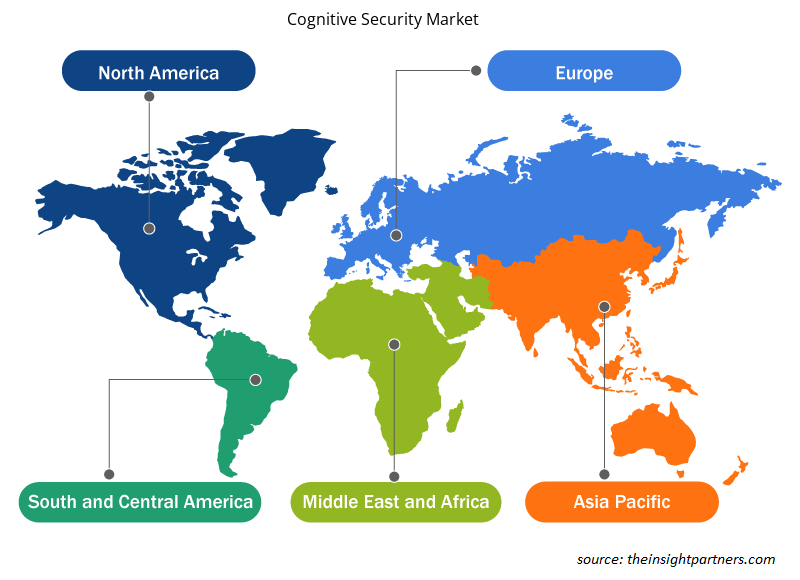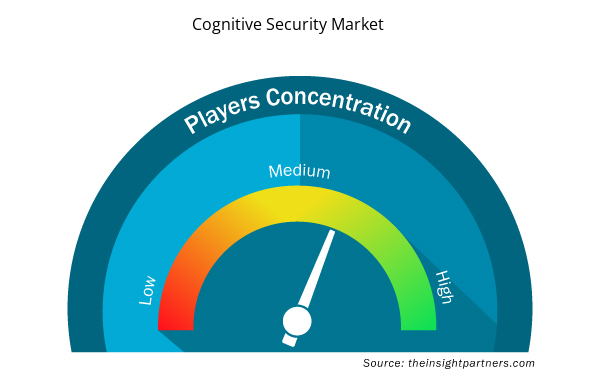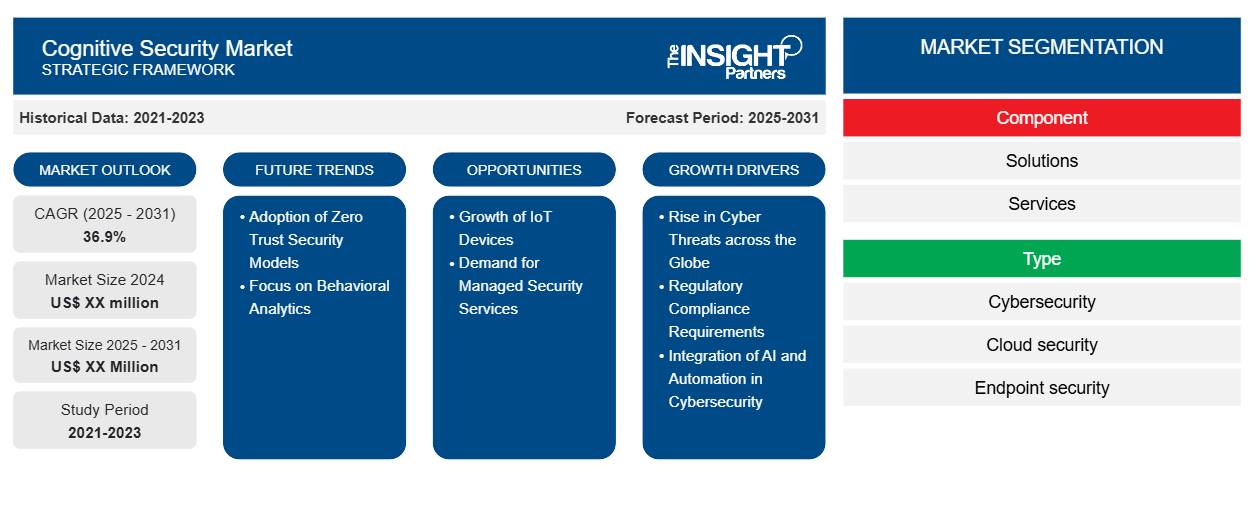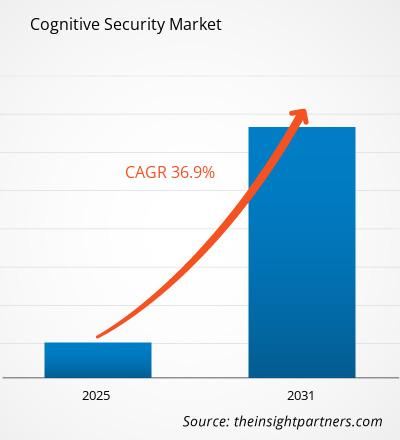Es wird erwartet, dass der Markt für kognitive Sicherheit von 2023 bis 2031 eine durchschnittliche jährliche Wachstumsrate (CAGR) von 36,9 % verzeichnet , wobei die Marktgröße von XX Millionen US-Dollar im Jahr 2023 auf XX Millionen US-Dollar bis 2031 wächst.
Der Bericht ist segmentiert nach Komponente (Lösungen, Dienste); Typ ( Cybersicherheit , Cloud-Sicherheit, Endpunktsicherheit, Anwendungssicherheit, Netzwerksicherheit, Sonstiges); Anwendung (Bedrohungsinformationen, automatisiertes Compliance-Management, Anomalieerkennung und Risikominderung, Sonstiges); Branche ( BFSI , IT und Telekommunikation, Luft- und Raumfahrt und Verteidigung, Fertigung, Einzelhandel, Gesundheitswesen, Regierung, Sonstiges). Die globale Analyse ist weiter auf regionaler Ebene und nach wichtigen Ländern aufgeschlüsselt. Der Bericht bietet den Wert in USD für die oben genannte Analyse und Segmente
Zweck des Berichts
Der Bericht Cognitive Security Market von The Insight Partners zielt darauf ab, die aktuelle Landschaft und das zukünftige Wachstum sowie die wichtigsten treibenden Faktoren, Herausforderungen und Chancen zu beschreiben. Dies wird verschiedenen Geschäftspartnern Einblicke geben, wie zum Beispiel:
- Technologieanbieter/-hersteller: Um die sich entwickelnde Marktdynamik zu verstehen und die potenziellen Wachstumschancen zu kennen, damit sie fundierte strategische Entscheidungen treffen können.
- Investoren: Durchführung einer umfassenden Trendanalyse hinsichtlich der Marktwachstumsrate, der finanziellen Marktprognosen und der Chancen entlang der Wertschöpfungskette.
- Regulierungsbehörden: Zur Regulierung von Richtlinien und Überwachungsaktivitäten auf dem Markt mit dem Ziel, Missbrauch zu minimieren, das Vertrauen der Anleger zu bewahren und die Integrität und Stabilität des Marktes aufrechtzuerhalten.
Kognitive Sicherheit Marktsegmentierung
Komponente
- Lösungen
- Dienstleistungen
Typ
- Cybersicherheit
- Cloud-Sicherheit
- Endgerätesicherheit
- Anwendungssicherheit
- Netzwerksicherheit
- Sonstiges
Anwendung
- Bedrohungsinformationen
- Automatisiertes Compliance-Management
- Anomalieerkennung und Risikominderung
- Sonstiges
Branchenvertikale
- BFSI
- IT und Telekommunikation
- Luft- und Raumfahrt und Verteidigung
- Herstellung
- Einzelhandel
- Gesundheitspflege
- Regierung
- Sonstiges
Branchenvertikale
- BFSI
- IT und Telekommunikation
- Luft- und Raumfahrt und Verteidigung
- Herstellung
- Einzelhandel
- Gesundheitspflege
- Regierung
- Sonstiges
Passen Sie diesen Bericht Ihren Anforderungen an
Sie erhalten kostenlos individuelle Anpassungen an jedem Bericht, einschließlich Teilen dieses Berichts oder einer Analyse auf Länderebene, eines Excel-Datenpakets sowie tolle Angebote und Rabatte für Start-ups und Universitäten.
- Holen Sie sich die wichtigsten Markttrends aus diesem Bericht.Dieses KOSTENLOSE Beispiel umfasst eine Datenanalyse von Markttrends bis hin zu Schätzungen und Prognosen.
Wachstumstreiber für den Markt für kognitive Sicherheit
- Anstieg von Cyberbedrohungen weltweit: Die zunehmende Häufigkeit und Raffinesse von Cyberbedrohungen sind wichtige Treiber des Marktes für kognitive Sicherheit. Da Unternehmen mit fortgeschrittenen, anhaltenden Bedrohungen, Ransomware-Angriffen und Datenlecks konfrontiert sind, besteht ein dringender Bedarf an verbesserten Sicherheitsmaßnahmen. Kognitive Sicherheit, die künstliche Intelligenz und maschinelles Lernen nutzt, ermöglicht eine proaktive Bedrohungserkennung und -reaktion, sodass Unternehmen Schwachstellen in Echtzeit identifizieren können. Dieses gesteigerte Bewusstsein für Cybersicherheitsrisiken treibt die Nachfrage nach kognitiven Sicherheitslösungen an und treibt das Marktwachstum voran, da Unternehmen dem Schutz ihrer digitalen Assets höchste Priorität einräumen.
- Anforderungen an die Einhaltung gesetzlicher Vorschriften: Strengere gesetzliche Rahmenbedingungen und Compliance-Anforderungen in allen Branchen treiben das Wachstum auf dem Markt für kognitive Sicherheit voran. Unternehmen müssen Vorschriften wie DSGVO, HIPAA und PCI DSS einhalten, die strenge Datenschutzmaßnahmen vorschreiben. Kognitive Sicherheitslösungen unterstützen Unternehmen bei der Automatisierung von Compliance-Prozessen, indem sie den Datenzugriff überwachen, Anomalien erkennen und Prüfpfade erstellen. Da Unternehmen bestrebt sind, diese gesetzlichen Anforderungen zu erfüllen und gleichzeitig die Datensicherheit zu gewährleisten, wird die Einführung kognitiver Sicherheitstechnologien immer wichtiger.
- Integration von KI und Automatisierung in die Cybersicherheit: Die Integration von künstlicher Intelligenz (KI) und Automatisierung in die Cybersicherheit ist ein wichtiger Treiber des Marktes für kognitive Sicherheit. Herkömmliche Sicherheitsmaßnahmen reichen oft nicht aus, um die Komplexität moderner Bedrohungen zu bewältigen. Kognitive Sicherheitssysteme nutzen KI-Algorithmen, um große Datenmengen zu analysieren, Muster zu erkennen und potenzielle Angriffe vorherzusagen. Diese Fähigkeit ermöglicht es Unternehmen, schnell auf neu auftretende Bedrohungen zu reagieren, was kognitive Sicherheit zu einer attraktiven Lösung für Unternehmen macht, die ihre Cybersicherheitslage und Betriebseffizienz verbessern möchten.
Zukünftige Trends auf dem Markt für kognitive Sicherheit
- Einführung von Zero-Trust-Sicherheitsmodellen: Ein wichtiger Trend auf dem Markt für kognitive Sicherheit ist die Einführung von Zero-Trust-Sicherheitsmodellen. Unternehmen erkennen zunehmend, dass herkömmliche perimeterbasierte Sicherheit in der heutigen Bedrohungslandschaft nicht ausreicht. Zero-Trust-Prinzipien betonen kontinuierliche Überprüfung und strenge Zugriffskontrollen, unabhängig vom Standort des Benutzers. Kognitive Sicherheitslösungen passen gut zu diesem Trend, indem sie Echtzeitanalysen und Bedrohungsinformationen bereitstellen und es Unternehmen ermöglichen, Zero-Trust-Frameworks effektiv zu implementieren. Dieser Wandel treibt die Nachfrage nach kognitiven Sicherheitstechnologien voran, die eine verbesserte Identitätsüberprüfung und Zugriffsverwaltung unterstützen.
- Fokus auf Verhaltensanalyse: Es gibt einen wachsenden Trend zur Einbindung von Verhaltensanalysen in kognitive Sicherheitslösungen. Durch die Analyse von Benutzerverhaltensmustern können kognitive Sicherheitssysteme Anomalien erkennen, die auf potenzielle Sicherheitsverletzungen oder Insider-Bedrohungen hinweisen können. Dieser proaktive Ansatz ermöglicht es Unternehmen, Bedrohungen effektiver zu erkennen und darauf zu reagieren. Da Unternehmen benutzerzentrierte Sicherheitsmaßnahmen priorisieren, wird die Integration von Verhaltensanalysen in kognitive Sicherheitslösungen voraussichtlich an Dynamik gewinnen und Innovationen und Marktwachstum vorantreiben, da Unternehmen versuchen, ihre allgemeine Sicherheitslage zu verbessern.
Marktchancen für kognitive Sicherheit
- Wachstum von IoT-Geräten: Die Verbreitung von IoT-Geräten (Internet of Things) bietet dem Markt für kognitive Sicherheit große Chancen. Da immer mehr Geräte mit Netzwerken verbunden werden, werden sie zu potenziellen Eintrittspunkten für Cyberbedrohungen. Kognitive Sicherheitslösungen können umfassenden Schutz bieten, indem sie Daten von diesen Geräten analysieren, Anomalien erkennen und Sicherheitsmaßnahmen in Echtzeit implementieren. Unternehmen, die auf IoT-Umgebungen zugeschnittene kognitive Sicherheitstechnologien entwickeln, können einen wachsenden Marktsegment erobern und die einzigartigen Herausforderungen bewältigen, die durch vernetzte Geräte entstehen.
- Nachfrage nach Managed Security Services: Die zunehmende Komplexität von Cybersicherheitsbedrohungen hat zu einer wachsenden Nachfrage nach Managed Security Services (MSS) geführt. Unternehmen lagern ihre Sicherheitsanforderungen an spezialisierte Anbieter aus, die kognitive Sicherheitslösungen anbieten. Dieser Trend bietet Anbietern kognitiver Sicherheit die Möglichkeit, mit MSSPs zusammenzuarbeiten und erweiterte Funktionen zur Bedrohungserkennung und -reaktion bereitzustellen. Durch den Einsatz kognitiver Technologien können Managed Security Services ihr Angebot erweitern, Unternehmen besseren Schutz und mehr Compliance bieten und so ihre Marktreichweite vergrößern.
Regionale Einblicke in den Markt für kognitive Sicherheit
Die regionalen Trends und Faktoren, die den Markt für kognitive Sicherheit im Prognosezeitraum beeinflussen, wurden von den Analysten von Insight Partners ausführlich erläutert. In diesem Abschnitt werden auch Marktsegmente und Geografien für kognitive Sicherheit in Nordamerika, Europa, im asiatisch-pazifischen Raum, im Nahen Osten und Afrika sowie in Süd- und Mittelamerika erörtert.

- Holen Sie sich die regionalspezifischen Daten für den Markt für kognitive Sicherheit
Umfang des Marktberichts zur kognitiven Sicherheit
| Berichtsattribut | Details |
|---|---|
| Marktgröße im Jahr 2023 | XX Millionen US-Dollar |
| Marktgröße bis 2031 | XX Millionen US-Dollar |
| Globale CAGR (2023 - 2031) | 36,9 % |
| Historische Daten | 2021-2022 |
| Prognosezeitraum | 2024–2031 |
| Abgedeckte Segmente | Nach Komponente
|
| Abgedeckte Regionen und Länder | Nordamerika
|
| Marktführer und wichtige Unternehmensprofile |
|
Dichte der Marktteilnehmer für kognitive Sicherheit: Die Auswirkungen auf die Geschäftsdynamik verstehen
Der Markt für kognitive Sicherheit wächst rasant, angetrieben durch die steigende Nachfrage der Endnutzer aufgrund von Faktoren wie sich entwickelnden Verbraucherpräferenzen, technologischen Fortschritten und einem größeren Bewusstsein für die Vorteile des Produkts. Mit steigender Nachfrage erweitern Unternehmen ihr Angebot, entwickeln Innovationen, um die Bedürfnisse der Verbraucher zu erfüllen, und nutzen neue Trends, was das Marktwachstum weiter ankurbelt.
Die Marktteilnehmerdichte bezieht sich auf die Verteilung der Firmen oder Unternehmen, die in einem bestimmten Markt oder einer bestimmten Branche tätig sind. Sie gibt an, wie viele Wettbewerber (Marktteilnehmer) in einem bestimmten Marktraum im Verhältnis zu seiner Größe oder seinem gesamten Marktwert präsent sind.
Die wichtigsten auf dem Markt für kognitive Sicherheit tätigen Unternehmen sind:
- Accenture
- BlackBerry Limited
- Cisco Systems, Inc.
- Tiefer Instinkt
- High-Tech Bridge SA
Haftungsausschluss : Die oben aufgeführten Unternehmen sind nicht in einer bestimmten Reihenfolge aufgeführt.

- Überblick über die wichtigsten Akteure auf dem Markt für kognitive Sicherheit
Wichtige Verkaufsargumente
- Umfassende Abdeckung: Der Bericht deckt die Analyse von Produkten, Diensten, Typen und Endbenutzern des Marktes für kognitive Sicherheit umfassend ab und bietet einen ganzheitlichen Überblick.
- Expertenanalyse: Der Bericht basiert auf dem umfassenden Verständnis von Branchenexperten und Analysten.
- Aktuelle Informationen: Der Bericht stellt durch die Abdeckung aktueller Informationen und Datentrends Geschäftsrelevanz sicher.
- Anpassungsoptionen: Dieser Bericht kann angepasst werden, um spezifische Kundenanforderungen zu erfüllen und die Geschäftsstrategien optimal anzupassen.
Der Forschungsbericht zum Markt für kognitive Sicherheit kann daher dabei helfen, die Branchensituation und Wachstumsaussichten zu entschlüsseln und zu verstehen. Obwohl es einige berechtigte Bedenken geben kann, überwiegen die allgemeinen Vorteile dieses Berichts tendenziell die Nachteile.
- Historische Analyse (2 Jahre), Basisjahr, Prognose (7 Jahre) mit CAGR
- PEST- und SWOT-Analyse
- Marktgröße Wert/Volumen – Global, Regional, Land
- Branche und Wettbewerbsumfeld
- Excel-Datensatz



Report Coverage
Revenue forecast, Company Analysis, Industry landscape, Growth factors, and Trends

Segment Covered
This text is related
to segments covered.

Regional Scope
North America, Europe, Asia Pacific, Middle East & Africa, South & Central America

Country Scope
This text is related
to country scope.
Häufig gestellte Fragen
Some of the customization options available based on the request are an additional 3-5 company profiles and country-specific analysis of 3-5 countries of your choice. Customizations are to be requested/discussed before making final order confirmation# as our team would review the same and check the feasibility
The report can be delivered in PDF/PPT format; we can also share excel dataset based on the request
Cloud-based security solutions to play a significant role in the global cognitive security market in the coming years
Growing Cyber-threat and AI and Machine Learning advancements are the major factors driving the cognitive security market
The Cognitive Security Market is estimated to witness a CAGR of 36.9% from 2023 to 2031
Trends and growth analysis reports related to Technology, Media and Telecommunications : READ MORE..
- Accenture
- BlackBerry Limited
- Cisco Systems, Inc.
- Deep Instinct
- High-Tech Bridge SA
- IBM
- LogRhythm, Inc.
- McAfee, LLC
- Securonix
- SparkCognition
The Insight Partners performs research in 4 major stages: Data Collection & Secondary Research, Primary Research, Data Analysis and Data Triangulation & Final Review.
- Data Collection and Secondary Research:
As a market research and consulting firm operating from a decade, we have published and advised several client across the globe. First step for any study will start with an assessment of currently available data and insights from existing reports. Further, historical and current market information is collected from Investor Presentations, Annual Reports, SEC Filings, etc., and other information related to company’s performance and market positioning are gathered from Paid Databases (Factiva, Hoovers, and Reuters) and various other publications available in public domain.
Several associations trade associates, technical forums, institutes, societies and organization are accessed to gain technical as well as market related insights through their publications such as research papers, blogs and press releases related to the studies are referred to get cues about the market. Further, white papers, journals, magazines, and other news articles published in last 3 years are scrutinized and analyzed to understand the current market trends.
- Primary Research:
The primarily interview analysis comprise of data obtained from industry participants interview and answers to survey questions gathered by in-house primary team.
For primary research, interviews are conducted with industry experts/CEOs/Marketing Managers/VPs/Subject Matter Experts from both demand and supply side to get a 360-degree view of the market. The primary team conducts several interviews based on the complexity of the markets to understand the various market trends and dynamics which makes research more credible and precise.
A typical research interview fulfils the following functions:
- Provides first-hand information on the market size, market trends, growth trends, competitive landscape, and outlook
- Validates and strengthens in-house secondary research findings
- Develops the analysis team’s expertise and market understanding
Primary research involves email interactions and telephone interviews for each market, category, segment, and sub-segment across geographies. The participants who typically take part in such a process include, but are not limited to:
- Industry participants: VPs, business development managers, market intelligence managers and national sales managers
- Outside experts: Valuation experts, research analysts and key opinion leaders specializing in the electronics and semiconductor industry.
Below is the breakup of our primary respondents by company, designation, and region:

Once we receive the confirmation from primary research sources or primary respondents, we finalize the base year market estimation and forecast the data as per the macroeconomic and microeconomic factors assessed during data collection.
- Data Analysis:
Once data is validated through both secondary as well as primary respondents, we finalize the market estimations by hypothesis formulation and factor analysis at regional and country level.
- Macro-Economic Factor Analysis:
We analyse macroeconomic indicators such the gross domestic product (GDP), increase in the demand for goods and services across industries, technological advancement, regional economic growth, governmental policies, the influence of COVID-19, PEST analysis, and other aspects. This analysis aids in setting benchmarks for various nations/regions and approximating market splits. Additionally, the general trend of the aforementioned components aid in determining the market's development possibilities.
- Country Level Data:
Various factors that are especially aligned to the country are taken into account to determine the market size for a certain area and country, including the presence of vendors, such as headquarters and offices, the country's GDP, demand patterns, and industry growth. To comprehend the market dynamics for the nation, a number of growth variables, inhibitors, application areas, and current market trends are researched. The aforementioned elements aid in determining the country's overall market's growth potential.
- Company Profile:
The “Table of Contents” is formulated by listing and analyzing more than 25 - 30 companies operating in the market ecosystem across geographies. However, we profile only 10 companies as a standard practice in our syndicate reports. These 10 companies comprise leading, emerging, and regional players. Nonetheless, our analysis is not restricted to the 10 listed companies, we also analyze other companies present in the market to develop a holistic view and understand the prevailing trends. The “Company Profiles” section in the report covers key facts, business description, products & services, financial information, SWOT analysis, and key developments. The financial information presented is extracted from the annual reports and official documents of the publicly listed companies. Upon collecting the information for the sections of respective companies, we verify them via various primary sources and then compile the data in respective company profiles. The company level information helps us in deriving the base number as well as in forecasting the market size.
- Developing Base Number:
Aggregation of sales statistics (2020-2022) and macro-economic factor, and other secondary and primary research insights are utilized to arrive at base number and related market shares for 2022. The data gaps are identified in this step and relevant market data is analyzed, collected from paid primary interviews or databases. On finalizing the base year market size, forecasts are developed on the basis of macro-economic, industry and market growth factors and company level analysis.
- Data Triangulation and Final Review:
The market findings and base year market size calculations are validated from supply as well as demand side. Demand side validations are based on macro-economic factor analysis and benchmarks for respective regions and countries. In case of supply side validations, revenues of major companies are estimated (in case not available) based on industry benchmark, approximate number of employees, product portfolio, and primary interviews revenues are gathered. Further revenue from target product/service segment is assessed to avoid overshooting of market statistics. In case of heavy deviations between supply and demand side values, all thes steps are repeated to achieve synchronization.
We follow an iterative model, wherein we share our research findings with Subject Matter Experts (SME’s) and Key Opinion Leaders (KOLs) until consensus view of the market is not formulated – this model negates any drastic deviation in the opinions of experts. Only validated and universally acceptable research findings are quoted in our reports.
We have important check points that we use to validate our research findings – which we call – data triangulation, where we validate the information, we generate from secondary sources with primary interviews and then we re-validate with our internal data bases and Subject matter experts. This comprehensive model enables us to deliver high quality, reliable data in shortest possible time.


 Holen Sie sich ein kostenloses Muster für diesen Bericht
Holen Sie sich ein kostenloses Muster für diesen Bericht